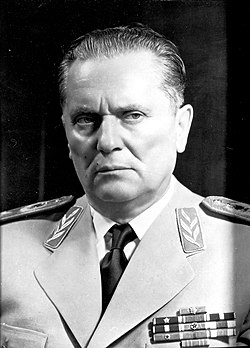| Presidency 1971–1974 |
| Name | Term of chairmanship | Representing |
|---|
| Josip Broz Tito | 30 June 1971 – 15 May 1974 | President of the Republic, President of the League of Communists of Yugoslavia |
Vidoje Žarković
Veljko Mićunović
Dobroslav Ćulafić | | SR Montenegro |
Josif Rajačić
Replaced by Sreten Kovačević
Maćaš Keleman
Replaced by Mrs. Ida Sabo | | SAP Vojvodina |
Ilaz Kurteshi
Veli Deva | | SAP Kosovo |
Nikola Minčev
Krste Crvenkovski
Kiro Gligorov
Replaced by Lazar Koliševski | | SR Macedonia |
Hamdija Pozderac
Ratomir Dugonjić
Augustin Papić | | SR Bosnia and Herzegovina |
Sergej Kraigher
Marko Bulc
Mitja Ribičič | | SR Slovenia |
Dragoslav Marković
Dobrivoje Vidić
Koča Popović
Replaced by Dragi Stamenković | | SR Serbia |
Jakov Blažević
Đuro Kladarin
Miko Tripalo
Replaced by Milan Mišković | | SR Croatia |
| Presidency 1974–1979 |
| Josip Broz Tito | 15 May 1974 – 15 May 1979 | President of the Republic, President of the League of Communists of Yugoslavia |
| Vidoje Žarković | | SR Montenegro |
| Stevan Doronjski | | SAP Vojvodina |
| Fadil Hoxha | | SAP Kosovo |
| Lazar Koliševski | | SR Macedonia |
| Cvijetin Mijatović | | SR Bosnia and Herzegovina |
Edvard Kardelj 1
1979 Sergej Kraigher | | SR Slovenia |
| Petar Stambolić | | SR Serbia |
| Vladimir Bakarić | | SR Croatia |
| Presidency 1979–1984 |
| Josip Broz Tito 1 | 15 May 1979 – 4 May 1980 | President of the Republic, President of the League of Communists of Yugoslavia |
| Vidoje Žarković | | SR Montenegro |
Stevan Doronjski 1
1981 Radovan Vlajković | | SAP Vojvodina |
| Fadil Hoxha | | SAP Kosovo |
| Lazar Koliševski | 4 May 1980 – 15 May 1980 | SR Macedonia |
| Cvijetin Mijatović | 15 May 1980 – 15 May 1981 | SR Bosnia and Herzegovina |
| Sergej Kraigher | 15 May 1981 – 15 May 1982 | SR Slovenia |
| Petar Stambolić | 15 May 1982 – 15 May 1983 | SR Serbia |
Vladimir Bakarić 1
1983 Mika Špiljak |
15 May 1983 – 15 May 1984 | SR Croatia |
1980 Stevan Doronjski
1980 Lazar Mojsov
1981 Dušan Dragosavac
1982 Mitja Ribičič
1983 Dragoslav Marković | | League of Communists of Yugoslavia |
| Presidency 1984–1989 |
| Veselin Đuranović | 15 May 1984 – 15 May 1985 | SR Montenegro |
| Radovan Vlajković | 15 May 1985 – 15 May 1986 | SAP Vojvodina |
| Sinan Hasani | 15 May 1986 – 15 May 1987 | SAP Kosovo |
| Lazar Mojsov | 15 May 1987 – 15 May 1988 | SR Macedonia |
Branko Mikulić 2
1986 Hamdija Pozderac 3
1987 Raif Dizdarević |
15 May 1988 – 15 May 1989 | SR Bosnia and Herzegovina |
| Stane Dolanc | | SR Slovenia |
| Nikola Ljubičić | | SR Serbia |
| Josip Vrhovec | | SR Croatia |
1984 Ali Shukri
1985 Vidoje Žarković
1986 Milanko Renovica
1987 Boško Krunić
1988 Stipe Šuvar
(until November 1988) | | League of Communists of Yugoslavia |
| Presidency 1989–1992 |
Dragutin Zelenović 5
1990 Jugoslav Kostić | | SAP Vojvodina |
Riza Sapunxhiu 6
1991 Sejdo Bajramović | | SAP Kosovo |
| Vasil Tupurkovski | | SR Macedonia / Republic of Macedonia |
| Bogić Bogićević | | SR Bosnia and Herzegovina |
| Janez Drnovšek | 15 May 1989 – 15 May 1990 | SR Slovenia / Republic of Slovenia |
| Borisav Jović | 15 May 1990 – 15 May 1991 | SR Serbia / Republic of Serbia |
Stipe Šuvar 4
1990 Stipe Mesić |
1 July 1991 – 3 October 1991 | SR Croatia / Republic of Croatia |
Nenad Bućin 7
1991 Branko Kostić |
6 December 1991 – 15 June 1992
(acting) | SR Montenegro |


